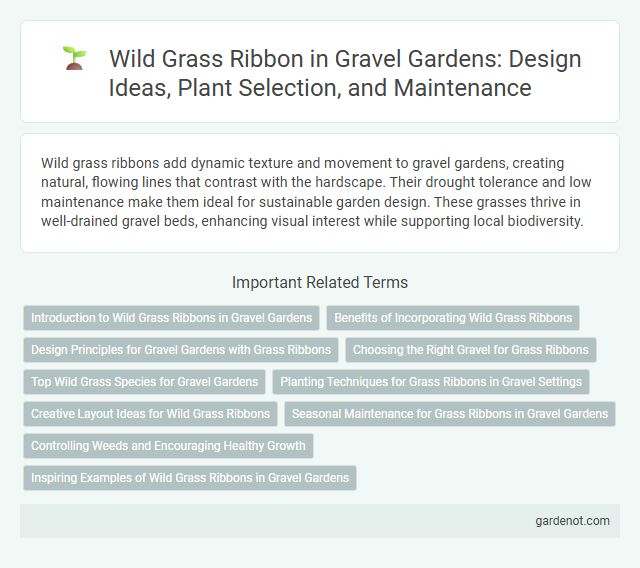Wild grass ribbons add dynamic texture and movement to gravel gardens, creating natural, flowing lines that contrast with the hardscape. Their drought tolerance and low maintenance make them ideal for sustainable garden design. These grasses thrive in well-drained gravel beds, enhancing visual interest while supporting local biodiversity.
Introduction to Wild Grass Ribbons in Gravel Gardens
Wild grass ribbons bring dynamic texture and natural movement to gravel gardens, thriving in well-drained soil with minimal maintenance. These ornamental grasses, such as Festuca and Carex species, create vibrant linear patterns that complement the gravel's rugged aesthetic. Their drought tolerance and adaptability make them ideal for sustainable, low-water garden designs.
Benefits of Incorporating Wild Grass Ribbons
Wild grass ribbons enhance gravel gardens by improving soil stability and preventing erosion with their dense root systems. Their natural texture and movement add visual interest and biodiversity, supporting pollinators and beneficial insects. Low maintenance and drought-resistant, wild grass ribbons contribute to sustainable, eco-friendly garden design.
Design Principles for Gravel Gardens with Grass Ribbons
Wild grass ribbons in gravel gardens create dynamic movement and soft textures while maintaining low maintenance requirements. Their linear growth pattern contrasts with the rough gravel, enhancing visual interest and guiding pathways through the space. Selecting drought-tolerant, native grasses ensures sustainability and resilience in gravel garden designs.
Choosing the Right Gravel for Grass Ribbons
Selecting the right gravel for a wild grass ribbon enhances drainage and complements the natural aesthetic of the planting. Opt for smaller, angular gravel between 5-10 mm to provide stability without suffocating grass roots. Light-colored gravels such as crushed granite or limestone reflect sunlight, promoting healthy growth while maintaining the garden's visual appeal.
Top Wild Grass Species for Gravel Gardens
Top wild grass species for gravel gardens include Blue Fescue (Festuca glauca), known for its fine-textured blue-green foliage that thrives in well-drained, sunny locations. Feather Reed Grass (Calamagrostis x acutiflora) offers vertical interest with its tall, slender stems and golden plumes, exhibiting strong drought tolerance ideal for gravel settings. Carex pendula, a shade-tolerant sedge with arching dark green leaves, provides an elegant contrast in gravel gardens, promoting biodiversity and low maintenance.
Planting Techniques for Grass Ribbons in Gravel Settings
Planting wild grass ribbons in gravel gardens requires careful soil preparation, ensuring well-draining, sandy substrates combined with organic matter to promote root health. Space grasses adequately to allow airflow and prevent disease, typically 30-45 cm apart, while planting at the same depth as their nursery pots for optimal establishment. Regular watering during the first growth phase and mulching around the base help retain moisture and reduce weed competition in gravel settings.
Creative Layout Ideas for Wild Grass Ribbons
Wild grass ribbons create dynamic visual interest in gravel gardens by weaving natural texture with structural design, enhancing both movement and contrast. Arranging wild grasses in curved or diagonal ribbons softens hardscape boundaries, promoting a flowing, organic aesthetic that maximizes space utility. Incorporating varying heights and species like Calamagrostis and Festuca diversifies color and form, enriching the sensory experience while supporting local biodiversity.
Seasonal Maintenance for Grass Ribbons in Gravel Gardens
Seasonal maintenance for Wild Grass Ribbon (Phalaris arundinacea) in gravel gardens involves cutting back the foliage in late winter to promote healthy new growth and prevent overcrowding. Removing dead or damaged stems helps maintain the plant's vibrant texture and enhances airflow, reducing the risk of disease. Applying a balanced fertilizer in early spring supports robust development, ensuring the grass remains an attractive, low-maintenance feature throughout the growing season.
Controlling Weeds and Encouraging Healthy Growth
Wild grass ribbon thrives in gravel gardens by effectively suppressing weed growth through dense root systems that outcompete invasive species. Its adaptability to poor soil conditions enhances soil structure and moisture retention, promoting vigorous and healthy plant development. Regular maintenance, including strategic trimming, ensures optimal air circulation and prevents overcrowding, fostering a sustainable and thriving gravel garden ecosystem.
Inspiring Examples of Wild Grass Ribbons in Gravel Gardens
Wild grass ribbons create striking linear accents in gravel gardens, enhancing texture and movement while requiring minimal maintenance. Examples like native fountain grass and blue fescue ribboned through gravel paths showcase how these resilient species add dynamic contrast and natural flow. Their drought tolerance and graceful seed heads provide visual interest year-round, making them ideal for sustainable, low-water landscapes.
Wild grass ribbon Infographic

 gardenot.com
gardenot.com